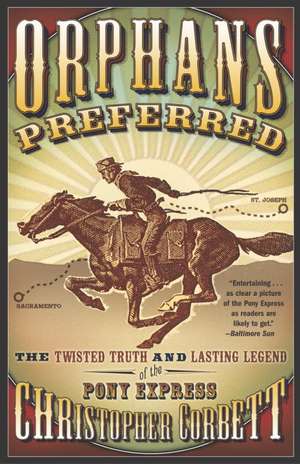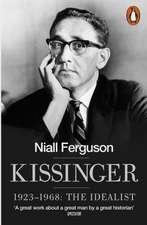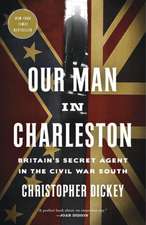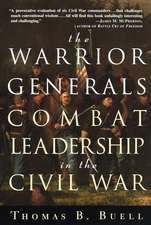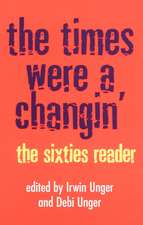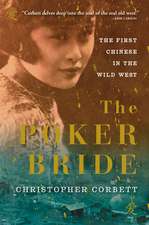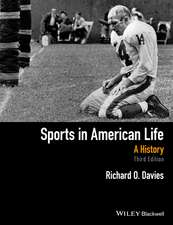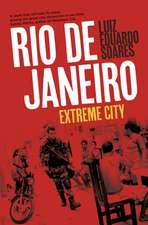Orphans Preferred: The Twisted Truth and Lasting Legend of the Pony Express
Autor Christopher Corbetten Limba Engleză Paperback – 31 aug 2004
—California newspaper help-wanted ad, 1860
The Pony Express is one of the most celebrated and enduring chapters in the history of the United States, a story of the all-American traits of bravery, bravado, and entrepreneurial risk that are part of the very fabric of the Old West. No image of the American West in the mid-1800s is more familiar, more beloved, and more powerful than that of the lone rider galloping the mail across hostile Indian territory. No image is more revered. And none is less understood. Orphans Preferred is both a revisionist history of this magnificent and ill-fated adventure and an entertaining look at the often larger-than-life individuals who created and perpetuated the myth of “the Pony,” as it is known along the Pony Express trail that runs from St. Joseph, Missouri, to Sacramento, California. The Pony Express is a story that exists in the annals of Americana where fact and fable collide, a story as heroic as the journey of Lewis and Clark, as complex and revealing as the legacy of Custer’s Last Stand, and as muddled and freighted with yarns as Paul Revere’s midnight ride. Orphans Preferred is a fresh and exuberant reexamination of this great American story.
Preț: 121.00 lei
Nou
Puncte Express: 182
Preț estimativ în valută:
23.15€ • 24.24$ • 19.27£
23.15€ • 24.24$ • 19.27£
Carte disponibilă
Livrare economică 10-24 martie
Preluare comenzi: 021 569.72.76
Specificații
ISBN-13: 9780767906937
ISBN-10: 0767906934
Pagini: 288
Dimensiuni: 132 x 206 x 16 mm
Greutate: 0.21 kg
Editura: BROADWAY BOOKS
ISBN-10: 0767906934
Pagini: 288
Dimensiuni: 132 x 206 x 16 mm
Greutate: 0.21 kg
Editura: BROADWAY BOOKS
Notă biografică
Christopher Corbett has been a working journalist for more than twenty-five years. A former news editor and reporter with the Associated Press, Corbett has also written for the New York Times, Washington Post, Philadelphia Inquirer, and Boston Globe. The author of the novel Vactionland, he lives in Baltimore and teaches journalism at the University of Maryland-Baltimore County.
Extras
One
"CAPITAL FELLOWS"--RUSSELL, MAJORS & WADDELL
My design is to give a truthful and not an exaggerated and fanciful account of the occurrences of the journey, and of the scenery, capabilities, and general features of the countries through which we shall pass, with incidental sketches of the leading characteristics of the populations.
--Edwin Bryant, What I Saw in California, 1848
In the spring of 1859 with carpetbag in hand, Horace Greeley, legendary editor of the New York Tribune, took the celebrated advice so often attributed to him and went west. He was no longer a young man that year--he was forty-eight--but he had the curiosity and energy of a young man.
"Want to learn what I can of that country with my own eyes," Greeley wrote, "and to study men in their cabins and at their work instead of reading about them in books."
Greeley, whom Harper's Weekly had called "the most perfect Yankee the country has ever produced," left New York City on May 9, traveled at first by rail and riverboat and then much of the way in a Concord coach, pitching and tossing across the continent. He would be on the road for five months. He traveled alone much of the time, too. "I then hoped, rather than confidently expected, that, on publicly announcing my intention, some friend might offer to bear me company on this journey; but my hope was not realized. One friend did propose to go; but his wife's veto overruled his not very stubborn resolve. I started alone . . ."
Horace Greeley was arguably the most influential and powerful opinion maker in the nation in those days. At the time of the Civil War, Abraham Lincoln compared Greeley's support to that of an army of 100,000 men in the field.
He was a flinty Yankee from poor New Hampshire who left his family farm and was apprenticed to a Vermont printer at fifteen, a printer's devil. When he was twenty, Greeley walked to New York City. He had ten dollars in his pocket. His first job was printing a tiny Bible.
He opposed slavery. He opposed the antiforeign, anti-Roman Catholic ravings of the Know-Nothings (he coined that term). He opposed tobacco (a bad experience with a cigar when he was five years old had turned him against smoking), he opposed alcohol (he took the pledge when he was but twelve), and he had reservations about the eating of meat. He rarely drank tea and had long forsworn coffee. He was a sometime vegetarian and a fairly strict disciple of the celebrated crank Dr. Sylvester Graham, whose cracker we remember a century and a half later. One biographer claimed that Greeley crossed the West eating graham crackers and drinking milk, but Greeley makes no mention of this diet in his travels. He met his wife at the Graham House, a New York City boardinghouse kept by Dr. Graham. She was an eccentric from New England, too.
A colleague described Greeley at the time as "careless and disheveled in dress as if he had put his clothes on in the dark, with the round and rosy face of a child and a cherubic expression of simplicity and gentleness . . . The power that he wielded was not equaled by any editor of his time--neither has it been equaled by any editor since."
He looked like an old baby from a very early age, with a soft, unlined pale face, a nearly bald head. He had poor eyesight made worse by his trade.
Greeley corresponded with Abraham Lincoln and Henry David Thoreau. Worshiped at a Unitarian Church in Manhattan with P. T. Barnum. Hired Karl Marx as a European correspondent. Published Charles Darwin for the first time in this country. Printed Edgar Allan Poe's "The Raven" in an American newspaper for the first time, too.
But he was first and foremost the founder and editor of the New York Tribune, the most influential newspaper in all of the United States in its heyday. Its weekly edition had 1 million readers. At the time of Greeley's western adventure, one of his reporters, Bayard Taylor, reported to him, "The Tribune comes next to the Bible all through the West."
Horace Greeley had been eager to turn his face westward, as he told his readers. The famous social reformer filed back to his newspaper a series of dispatches reporting on everything from his disapproval of shooting buffalo (he was quite certain that he had seen a million of them), to the plight of the abused Chinese miners in the West, to his prediction that the next great cities of the United States would be in Kansas: Atchison and Leavenworth.
He saw wild Indians (he thought little of them) and desperadoes (he disapproved) and drunkards (he disapproved) and gunplay (he disapproved). He survived a stampede of buffalo; they overturned his stagecoach, leaving him shaken but uninjured. He hit Denver when it was a remote mining town, six months old. The West was, indeed, wild. Greeley reported:
There is a fighting class among the settlers in the Rocky Mountains. This class is not numerous, but it is more influential than it should be in giving tone to the society of which its members form a part. Prone to deep thinking, soured in temper, always armed, bristling at a word, ready with the rifle, revolver, or bowie knife, they give law and set fashions which, in a country where the regular administration of justice is yet a matter of prophecy, it seems difficult to overrule or disregard. I apprehend that there have been, during my two weeks' sojourn, more brawls, more fights, more pistols shot with criminal intent, in this log city of one hundred and fifty dwellings, not three fourths completed nor two thirds inhabited, nor one third fit to be, than in any community of no greater numbers on earth.
Greeley moved on to Salt Lake City, the Mormon Jerusalem, where he visited Brigham Young at a time when Mormons were regarded as variously dangerous and ridiculous. They discussed polygamy, the apostle Paul, slavery. Greeley crossed the Great Basin when Utah and Nevada were nearly uninhabited. He estimated that there were fewer than five thousand people living in all of Nevada. Carson City was a handful of shacks. Virginia City was a mining claim.
Wherever Horace Greeley went, he was grandly received. His opinion mattered and his impressions did, too. Greeley's was a whirlwind trip; often he stopped only briefly to see the sights and then raced on in the next westbound stage. "Greeley has come and gone," reported the Sacramento Union. He had stopped in the California capital for a mere thirteen hours. He was out west in support of a transcontinental railroad.
Enormous crowds turned out to see Greeley when he alighted from the stagecoach. He wore "a very rusty and well-worn white coat, a still rustier and still more worn and faded blue-cotton umbrella . . ." A famous photograph of the time shows Greeley wearing a tall white hat. And his ever-present spectacles. His eyes were always poor. He squinted.
Writing about Greeley's western sojourn more than forty years later, George Tisdale Bromley, a celebrated Californian of that era, recalled its importance. "He was looked upon at that time as the greatest man who had ever visited California, and glorious results were anticipated on his return East, from his efforts in behalf of the great Atlantic and Pacific Railroad." The trip resulted in a book the next year: An Overland Journey from New York to San Francisco in the Summer of 1859.
During Horace Greeley's "celebrated journey across the Plains to California," he encountered the greatest force of progress on the frontier in the years before the telegraph and the railroad crossed the countryside. In eastern Kansas, on the edge of the wilderness, Greeley observed the mighty freight-hauling firm of Russell, Majors & Waddell, the major carrier of all freight in the United States west of the Mississippi River in the middle of the nineteenth century, an organization that later narrators dubbed "an empire on wheels."
The firm made its headquarters at Leavenworth, Kansas--a riverfront town fifty miles southwest of St. Joseph, Missouri. Horace Greeley found it an impressive operation:
. . . Russell, Majors & Waddell's transportation establishment, between the fort and the city, is the great feature of Leavenworth. Such acres of wagons! such pyramids of extra axletrees! such herds of oxen! such regiments of drivers and employees! No one who does not see can realize how vast a business this is, nor how immense are its outlays as well as its income. I presume this great firm has at this hour two millions of dollars invested in stock, mainly oxen, mules, and wagons. (They last employed six thousand teamsters, and worked forty-five thousand oxen.)
The firm that bore the names of William Russell, Alexander Majors and William Waddell (Greeley described them as "capital fellows," though it's not clear whether he actually met them) was in its heyday the greatest force in shipping goods west in the country. Fueled by a virtual monopoly on providing freight service for a vast network of U.S. military outposts, the firm was prosperous and respected all along the frontier. Very little went west if it did not travel on an ox-drawn wagon owned by Russell, Majors & Waddell.
In the years before the Civil War, travelers into the West would have known well the names Russell, Majors & Waddell. They were the Mayflower Van Line of their time, the United Parcel Service of the prairie, the FedEx of the frontier. In the years before the railroads crossed the Great Plains, when there were still wolves in Kansas and Nebraska and wild Indians, no freight--either military or domestic--went west down the Santa Fe Trail or out to Fort McKay or to Fort Kearny or one of the handful of remote army posts that dotted the Great American Desert unless it did so on a miles-long train of Conestoga wagons pulled by plodding oxen teams. Most of those outfits were owned by Russell, Majors & Waddell.
John D. Young, a Chicagoan bound for the gold fields of Colorado in 1860, reported encountering immense government wagon trains on the plains of Kansas and Nebraska--owned and operated by Russell, Majors & Waddell. According to Young's journal, preserved at the Newberry Library in Chicago, twenty thousand people traveled with some of these trains, stretching out for many miles across the prairies.
In the spring of 1860, following Greeley's overland adventure, with the nation perched on the brink of civil war, Russell, Majors & Waddell established a subsidiary business, a privately financed gamble designed to prove that mail could be moved quickly--in ten days or less across nearly two thousand miles of still-wild North America. To do this, they would use a relay system of experienced riders and the best horses money could buy. No one today remembers the names Russell, Majors & Waddell or the vast freighting empire they presided over in the good years before the Civil War. No one remembers their rolling armada of tens of thousands of oxen, vast fleets of wagons, or armies of bullwhackers--the greatest such venture of its kind ever assembled.
Their legacy would be the most obscure of footnotes in the history of the opening of the American West but for the little venture into which they poured their fates and fortunes. They spun the business off their stage line operations linking the Missouri with Denver and Salt Lake City, calling it the Central Overland California & Pike's Peak Express Company. The name was too long--even its initials, COC&PPEC, were too cumbersome--and so it was called simply the Pony Express.
Louisa P. Johnston, the great-granddaughter of Alexander Majors, recalled more than a century later: "A clerk of the firm wrote that all the company's wagon trains together would stretch forty miles. Russell, Majors and Waddell were freighting to Santa Fe and to all the U.S. Army posts in the West. They ran stage lines to Denver and Salt Lake City. So they were uniquely equipped to start a pony express."
The Pony Express was a daring and madcap and foolish idea. It was thought to be impossible (men wagered against it ever happening) to race a satchel, a saddlebag called a mochila, holding about twenty pounds of important mail written on the lightest tissue paper, across nearly two thousand miles of largely uninhabited and hostile country, country where there were no railroads, no telegraphs, and few towns. Two thousand miles. They would do this in ten days, less than half the time that it was then taking to move mail from "the Atlantic states" to "the far coast." They would do this eventually in even fewer days: the news of Abraham Lincoln's inaugural message crossed the country in a record seven days and seventeen hours.
Colonel Henry Inman, a great historian of nineteenth-century western travel, called the transcontinental feat "the quickest time for horseback riding, considering the distance made, ever accomplished in this or any other country."
Russell, Majors & Waddell would move a horse and rider across the continent, night and day, in all weather and in all seasons of the year. Their critics would say later that it was all a wild publicity stunt. What did it really prove? What did it matter? But on the frontier in 1860 when there was no railroad and no telegraph and "the states" were far, far away, when the known world ended at the Missouri River and mail could take months coming back and forth from east to west, men who had not had a letter from home for a year stood in the streets of California and cheered the coming and going of the Pony Express.
William Hepburn Russell, the senior partner in the then-famous firm, appears from the distance of nearly a century and a half a bit of a dude, an opportunist, a fancy dresser and self-made city slicker, an upwardly mobile general store clerk, a hustler, a talker, a man who liked the creature comforts. He spent little time in the West, preferring the easy life of New York and Washington. The newspapers called him variously the Brains of the Border and the Napoleon of the Plains. What did the newspapers know? He barely knew the border or the plains. He better knew the drawing room and the parlor car on the railroad. He liked a good hotel. He liked a good cigar. He liked to dress for dinner. He liked linen shirts and good suits. He was rich. Although he spent no time there, he was one of the founders of Denver. The halls of power in Washington and New York, where there were investors, deals, and government contracts, beckoned him, not the open spaces across the wide Missouri. His biographers have always stressed that he knew nothing about the frontier based on any firsthand experience. William Hepburn Russell was no plainsman.
Various writers recall that he was known, in the parlance of his day, as a plunger: a risk taker, a gambler, a speculator. An early observer of Russell's business ventures, some of which were not successful, called them Russell's Follies. He was deeply offended by criticism and angrily wrote once to his partner William Waddell, who fretted over Russell's antics, to chastise those who thought so of him: "I am not a reckless gambler and I will not be so posted."
From the Hardcover edition.
"CAPITAL FELLOWS"--RUSSELL, MAJORS & WADDELL
My design is to give a truthful and not an exaggerated and fanciful account of the occurrences of the journey, and of the scenery, capabilities, and general features of the countries through which we shall pass, with incidental sketches of the leading characteristics of the populations.
--Edwin Bryant, What I Saw in California, 1848
In the spring of 1859 with carpetbag in hand, Horace Greeley, legendary editor of the New York Tribune, took the celebrated advice so often attributed to him and went west. He was no longer a young man that year--he was forty-eight--but he had the curiosity and energy of a young man.
"Want to learn what I can of that country with my own eyes," Greeley wrote, "and to study men in their cabins and at their work instead of reading about them in books."
Greeley, whom Harper's Weekly had called "the most perfect Yankee the country has ever produced," left New York City on May 9, traveled at first by rail and riverboat and then much of the way in a Concord coach, pitching and tossing across the continent. He would be on the road for five months. He traveled alone much of the time, too. "I then hoped, rather than confidently expected, that, on publicly announcing my intention, some friend might offer to bear me company on this journey; but my hope was not realized. One friend did propose to go; but his wife's veto overruled his not very stubborn resolve. I started alone . . ."
Horace Greeley was arguably the most influential and powerful opinion maker in the nation in those days. At the time of the Civil War, Abraham Lincoln compared Greeley's support to that of an army of 100,000 men in the field.
He was a flinty Yankee from poor New Hampshire who left his family farm and was apprenticed to a Vermont printer at fifteen, a printer's devil. When he was twenty, Greeley walked to New York City. He had ten dollars in his pocket. His first job was printing a tiny Bible.
He opposed slavery. He opposed the antiforeign, anti-Roman Catholic ravings of the Know-Nothings (he coined that term). He opposed tobacco (a bad experience with a cigar when he was five years old had turned him against smoking), he opposed alcohol (he took the pledge when he was but twelve), and he had reservations about the eating of meat. He rarely drank tea and had long forsworn coffee. He was a sometime vegetarian and a fairly strict disciple of the celebrated crank Dr. Sylvester Graham, whose cracker we remember a century and a half later. One biographer claimed that Greeley crossed the West eating graham crackers and drinking milk, but Greeley makes no mention of this diet in his travels. He met his wife at the Graham House, a New York City boardinghouse kept by Dr. Graham. She was an eccentric from New England, too.
A colleague described Greeley at the time as "careless and disheveled in dress as if he had put his clothes on in the dark, with the round and rosy face of a child and a cherubic expression of simplicity and gentleness . . . The power that he wielded was not equaled by any editor of his time--neither has it been equaled by any editor since."
He looked like an old baby from a very early age, with a soft, unlined pale face, a nearly bald head. He had poor eyesight made worse by his trade.
Greeley corresponded with Abraham Lincoln and Henry David Thoreau. Worshiped at a Unitarian Church in Manhattan with P. T. Barnum. Hired Karl Marx as a European correspondent. Published Charles Darwin for the first time in this country. Printed Edgar Allan Poe's "The Raven" in an American newspaper for the first time, too.
But he was first and foremost the founder and editor of the New York Tribune, the most influential newspaper in all of the United States in its heyday. Its weekly edition had 1 million readers. At the time of Greeley's western adventure, one of his reporters, Bayard Taylor, reported to him, "The Tribune comes next to the Bible all through the West."
Horace Greeley had been eager to turn his face westward, as he told his readers. The famous social reformer filed back to his newspaper a series of dispatches reporting on everything from his disapproval of shooting buffalo (he was quite certain that he had seen a million of them), to the plight of the abused Chinese miners in the West, to his prediction that the next great cities of the United States would be in Kansas: Atchison and Leavenworth.
He saw wild Indians (he thought little of them) and desperadoes (he disapproved) and drunkards (he disapproved) and gunplay (he disapproved). He survived a stampede of buffalo; they overturned his stagecoach, leaving him shaken but uninjured. He hit Denver when it was a remote mining town, six months old. The West was, indeed, wild. Greeley reported:
There is a fighting class among the settlers in the Rocky Mountains. This class is not numerous, but it is more influential than it should be in giving tone to the society of which its members form a part. Prone to deep thinking, soured in temper, always armed, bristling at a word, ready with the rifle, revolver, or bowie knife, they give law and set fashions which, in a country where the regular administration of justice is yet a matter of prophecy, it seems difficult to overrule or disregard. I apprehend that there have been, during my two weeks' sojourn, more brawls, more fights, more pistols shot with criminal intent, in this log city of one hundred and fifty dwellings, not three fourths completed nor two thirds inhabited, nor one third fit to be, than in any community of no greater numbers on earth.
Greeley moved on to Salt Lake City, the Mormon Jerusalem, where he visited Brigham Young at a time when Mormons were regarded as variously dangerous and ridiculous. They discussed polygamy, the apostle Paul, slavery. Greeley crossed the Great Basin when Utah and Nevada were nearly uninhabited. He estimated that there were fewer than five thousand people living in all of Nevada. Carson City was a handful of shacks. Virginia City was a mining claim.
Wherever Horace Greeley went, he was grandly received. His opinion mattered and his impressions did, too. Greeley's was a whirlwind trip; often he stopped only briefly to see the sights and then raced on in the next westbound stage. "Greeley has come and gone," reported the Sacramento Union. He had stopped in the California capital for a mere thirteen hours. He was out west in support of a transcontinental railroad.
Enormous crowds turned out to see Greeley when he alighted from the stagecoach. He wore "a very rusty and well-worn white coat, a still rustier and still more worn and faded blue-cotton umbrella . . ." A famous photograph of the time shows Greeley wearing a tall white hat. And his ever-present spectacles. His eyes were always poor. He squinted.
Writing about Greeley's western sojourn more than forty years later, George Tisdale Bromley, a celebrated Californian of that era, recalled its importance. "He was looked upon at that time as the greatest man who had ever visited California, and glorious results were anticipated on his return East, from his efforts in behalf of the great Atlantic and Pacific Railroad." The trip resulted in a book the next year: An Overland Journey from New York to San Francisco in the Summer of 1859.
During Horace Greeley's "celebrated journey across the Plains to California," he encountered the greatest force of progress on the frontier in the years before the telegraph and the railroad crossed the countryside. In eastern Kansas, on the edge of the wilderness, Greeley observed the mighty freight-hauling firm of Russell, Majors & Waddell, the major carrier of all freight in the United States west of the Mississippi River in the middle of the nineteenth century, an organization that later narrators dubbed "an empire on wheels."
The firm made its headquarters at Leavenworth, Kansas--a riverfront town fifty miles southwest of St. Joseph, Missouri. Horace Greeley found it an impressive operation:
. . . Russell, Majors & Waddell's transportation establishment, between the fort and the city, is the great feature of Leavenworth. Such acres of wagons! such pyramids of extra axletrees! such herds of oxen! such regiments of drivers and employees! No one who does not see can realize how vast a business this is, nor how immense are its outlays as well as its income. I presume this great firm has at this hour two millions of dollars invested in stock, mainly oxen, mules, and wagons. (They last employed six thousand teamsters, and worked forty-five thousand oxen.)
The firm that bore the names of William Russell, Alexander Majors and William Waddell (Greeley described them as "capital fellows," though it's not clear whether he actually met them) was in its heyday the greatest force in shipping goods west in the country. Fueled by a virtual monopoly on providing freight service for a vast network of U.S. military outposts, the firm was prosperous and respected all along the frontier. Very little went west if it did not travel on an ox-drawn wagon owned by Russell, Majors & Waddell.
In the years before the Civil War, travelers into the West would have known well the names Russell, Majors & Waddell. They were the Mayflower Van Line of their time, the United Parcel Service of the prairie, the FedEx of the frontier. In the years before the railroads crossed the Great Plains, when there were still wolves in Kansas and Nebraska and wild Indians, no freight--either military or domestic--went west down the Santa Fe Trail or out to Fort McKay or to Fort Kearny or one of the handful of remote army posts that dotted the Great American Desert unless it did so on a miles-long train of Conestoga wagons pulled by plodding oxen teams. Most of those outfits were owned by Russell, Majors & Waddell.
John D. Young, a Chicagoan bound for the gold fields of Colorado in 1860, reported encountering immense government wagon trains on the plains of Kansas and Nebraska--owned and operated by Russell, Majors & Waddell. According to Young's journal, preserved at the Newberry Library in Chicago, twenty thousand people traveled with some of these trains, stretching out for many miles across the prairies.
In the spring of 1860, following Greeley's overland adventure, with the nation perched on the brink of civil war, Russell, Majors & Waddell established a subsidiary business, a privately financed gamble designed to prove that mail could be moved quickly--in ten days or less across nearly two thousand miles of still-wild North America. To do this, they would use a relay system of experienced riders and the best horses money could buy. No one today remembers the names Russell, Majors & Waddell or the vast freighting empire they presided over in the good years before the Civil War. No one remembers their rolling armada of tens of thousands of oxen, vast fleets of wagons, or armies of bullwhackers--the greatest such venture of its kind ever assembled.
Their legacy would be the most obscure of footnotes in the history of the opening of the American West but for the little venture into which they poured their fates and fortunes. They spun the business off their stage line operations linking the Missouri with Denver and Salt Lake City, calling it the Central Overland California & Pike's Peak Express Company. The name was too long--even its initials, COC&PPEC, were too cumbersome--and so it was called simply the Pony Express.
Louisa P. Johnston, the great-granddaughter of Alexander Majors, recalled more than a century later: "A clerk of the firm wrote that all the company's wagon trains together would stretch forty miles. Russell, Majors and Waddell were freighting to Santa Fe and to all the U.S. Army posts in the West. They ran stage lines to Denver and Salt Lake City. So they were uniquely equipped to start a pony express."
The Pony Express was a daring and madcap and foolish idea. It was thought to be impossible (men wagered against it ever happening) to race a satchel, a saddlebag called a mochila, holding about twenty pounds of important mail written on the lightest tissue paper, across nearly two thousand miles of largely uninhabited and hostile country, country where there were no railroads, no telegraphs, and few towns. Two thousand miles. They would do this in ten days, less than half the time that it was then taking to move mail from "the Atlantic states" to "the far coast." They would do this eventually in even fewer days: the news of Abraham Lincoln's inaugural message crossed the country in a record seven days and seventeen hours.
Colonel Henry Inman, a great historian of nineteenth-century western travel, called the transcontinental feat "the quickest time for horseback riding, considering the distance made, ever accomplished in this or any other country."
Russell, Majors & Waddell would move a horse and rider across the continent, night and day, in all weather and in all seasons of the year. Their critics would say later that it was all a wild publicity stunt. What did it really prove? What did it matter? But on the frontier in 1860 when there was no railroad and no telegraph and "the states" were far, far away, when the known world ended at the Missouri River and mail could take months coming back and forth from east to west, men who had not had a letter from home for a year stood in the streets of California and cheered the coming and going of the Pony Express.
William Hepburn Russell, the senior partner in the then-famous firm, appears from the distance of nearly a century and a half a bit of a dude, an opportunist, a fancy dresser and self-made city slicker, an upwardly mobile general store clerk, a hustler, a talker, a man who liked the creature comforts. He spent little time in the West, preferring the easy life of New York and Washington. The newspapers called him variously the Brains of the Border and the Napoleon of the Plains. What did the newspapers know? He barely knew the border or the plains. He better knew the drawing room and the parlor car on the railroad. He liked a good hotel. He liked a good cigar. He liked to dress for dinner. He liked linen shirts and good suits. He was rich. Although he spent no time there, he was one of the founders of Denver. The halls of power in Washington and New York, where there were investors, deals, and government contracts, beckoned him, not the open spaces across the wide Missouri. His biographers have always stressed that he knew nothing about the frontier based on any firsthand experience. William Hepburn Russell was no plainsman.
Various writers recall that he was known, in the parlance of his day, as a plunger: a risk taker, a gambler, a speculator. An early observer of Russell's business ventures, some of which were not successful, called them Russell's Follies. He was deeply offended by criticism and angrily wrote once to his partner William Waddell, who fretted over Russell's antics, to chastise those who thought so of him: "I am not a reckless gambler and I will not be so posted."
From the Hardcover edition.
Recenzii
“A lively and conversational probe that lays out the real facts about this stirring slice of Americana.”—Albuquerque Journal
“A rollicking tale of frontiersmen, showmen, hustlers, hucksters, and frauds.”
—CNN
“It’s the West in microcosm, and Corbett’s breezy writing turns what we thought we knew into a compelling search for fact . . . It’s a romantic story that won’t die.”
—Denver Post
“A rollicking tale of frontiersmen, showmen, hustlers, hucksters, and frauds.”
—CNN
“It’s the West in microcosm, and Corbett’s breezy writing turns what we thought we knew into a compelling search for fact . . . It’s a romantic story that won’t die.”
—Denver Post
Descriere
"Orphans Preferred" is both a revisionist history of the magnificent and ill-fated adventure of the Pony Express and an entertaining look at the often larger-than-life individuals who created and perpetuated the myth. Illustrations.
